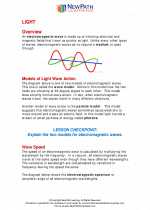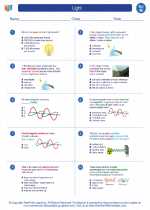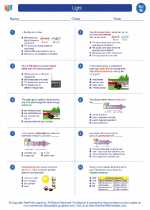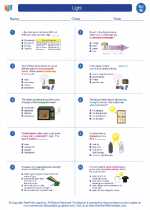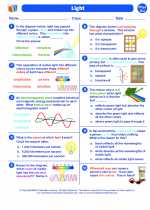Light: Explained
Light is a form of electromagnetic radiation that is visible to the human eye. It is a type of energy that travels in waves and behaves both as a particle and a wave. Understanding the properties and behaviors of light is important in various fields such as physics, optics, and astronomy.
Properties of Light
- Wavelength: The distance between two consecutive peaks or troughs of a light wave. It determines the color of light - shorter wavelengths appear blue, while longer wavelengths appear red.
- Frequency: The number of wave cycles that pass a given point in one second. It is inversely proportional to the wavelength.
- Speed: In a vacuum, light travels at a constant speed of approximately 299,792 kilometers per second.
- Reflection: The bouncing back of light when it encounters a surface, such as a mirror.
- Refraction: The bending of light as it passes from one medium to another, such as from air to water or glass.
- Dispersion: The separation of light into its different colors, as seen in a rainbow or when white light passes through a prism.
Behavior of Light
Light can exhibit various behaviors, which include:
- Wave-Particle Duality: The concept that light can behave as both a wave and a stream of particles called photons.
- Interference: The interaction of two or more light waves, leading to the reinforcement or cancellation of the waves.
- Diffraction: The bending of light waves around obstacles or through narrow openings.
- Polarization: The orientation of light waves in a specific direction, often achieved by passing light through a polarizing filter.
Applications of Light
Light has numerous practical applications in everyday life and in various scientific fields, including:
- Optics: The study of light and its interactions with lenses, mirrors, and other optical devices.
- Photography: The capture and manipulation of light to create images.
- Medical Imaging: The use of light-based technologies such as X-rays, MRI, and CT scans for diagnostic purposes.
- Communication: The transmission of information through fiber optic cables, which rely on light to carry data signals.
- Astronomy: The study of celestial objects and phenomena using light-based observations and telescopes.
Study Guide: Light
Key Concepts to Understand
- What is the electromagnetic spectrum and where does visible light fall within it?
- How does the wavelength of light relate to its color?
- What are the properties of light waves and how do they differ from other types of waves?
- Explain the phenomena of reflection, refraction, and dispersion in the context of light.
- Describe the wave-particle duality of light and its significance in the field of quantum mechanics.
Experiments and Demonstrations
Performing experiments and demonstrations can help reinforce the understanding of light's properties and behaviors. Consider conducting the following activities:
- Investigate the behavior of light using mirrors and lenses to understand reflection and refraction.
- Create a simple spectroscope to observe the dispersion of light into its component colors.
- Explore the concept of polarization by using polarizing filters to alter the orientation of light waves.
Real-World Applications
Research and present on the practical uses of light in various scientific and technological fields, such as in medical imaging, telecommunications, and astronomy. Discuss how advancements in understanding light have led to innovations in these areas.
